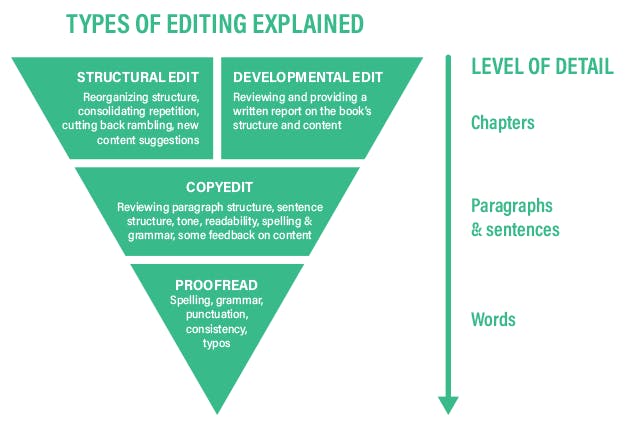The 3, no, 4! (or is it 5?) Types of Tech Editing
We can't agree on what they're called, and it doesn't matter anyway
There are many different names used to describe the different types of editing. The waters are murky—and the hosts of The Editing Podcast agree. In The different levels of editing episode, Louise exclaims, "The language of editing is so tangled!". And Denise adds, "Many of my clients aren't aware of these definitions - they just want "editing."
Types of Technical Editing
I did a flypast of some sources to capture the variety of editing terminology, and how confusing it can be for a non-editor.
Not only can the same type of editing be referred to by different names, but the definitive process is sometimes represented as having three, four, or five (or even six!) stages.
Three types of editing
IPEd, The Writing Cooperative, and CIEP all present three types of editing - but not the same three:
Substantive, Copy editing, Proofreading The Institute of Professional Editors (IPEd)
Developmental, Line editing, Copy editing The Writing Cooperative
Structural, Copy editing, Proofreading The Chartered Institute of Editing and Proofreading UK (CIEP)
Four types of editing
The Editing Podcast, The Grammar Factory, and Editors Canada present four types of editing, and here we see some muddying of the waters with synonyms.
Developmental, Line editing, Copy editing, Proofreading The Editing Podcast
Developmental, Structural, Copy editing, Proofreading The Grammar Factory
Structural, Stylistic, Copy editing, Proofreading Editors Canada
The Editing Mastery course by Shani Raja and the Editing Essentials course by ComTech both teach four types of editing - these seem closer in terminology:
Content, Structure, Style, Presentation Editing Mastery course by Shani Raja
Context, Structural, Stylistic, Copy Editing Essentials course by ComTech
Five types of editing
Archway Publishing, Right Touch Editing, and the Reedsy Blog go one better, listing five types of editing:
Developmental, Substantive, Mechanical, Line editing, Copy editing Archway Publishing
Developmental, Stylistic, Copy editing, Fact-checking, Proofreading Right Touch Editing
Editorial assessment, Developmental, Copy editing, Fact-checking, Proofreading The Reedsy Blog
Six types of editing
Knowledge Owl rounds it out to an even six - but is this going too far?
- Language, Format, Functional, Substantive, Mechanical, Integrity
Levels and Passes
Despite this variation in terminology, the key message is that there are different, distinct editing activities; and they must be performed in a particular order.
The types of editing refer to different levels of review of the content: macro and micro. Each level requires a different mindset. At the macro level, I'm thinking strategically; at the mid-level, I'm looking at phrasing, color, and flow; at the micro-level, I'm in correction mode.
An editor will do more than one pass on a piece of content, looking at different things each time. It's essential to allow time for several passes. While some types of editing can be combined (for example, many editors instinctively do line editing and copy editing at the same stage), perfection is impossible in just one pass.
Order of Play
There is a logical order to editing. Think of the metaphor of a house, inverted pyramid, or nesting dolls—an editor starts with the bigger picture and then moves progressively to the micro-level. The order of play is important!
"If you swap the order of editing around, you can end up in a real pickle."—Denise Cowle, The Editing Podcast
The house
The Editing Podcast uses the metaphor of building a house to demonstrate the logical order of editing.
Developmental editing is like laying the foundations and building the structure. Line and copy editing is the plaster, brickwork, painting the walls, and sanding the floor. Finally, proofreading is when you move in the furniture and fill in tiny cracks in the walls.
The inverted pyramid
The Grammar Factory uses an inverted pyramid to illustrate the process—starting with the broader structural and developmental edits then moving down to the micro-level of detail.

The nesting dolls
Open Strategy Partners uses the idea of nesting dolls to show that you can't start looking at word choice before you've looked at structure and flow. They also do a separate Positivity Pass as part of their process.

Managing Expectations
Wordsmiths and editors might appreciate the nuance between terms such as "line editing" and "copy editing," but tech writers aren't typing these terms into a search engine. They're more likely to use the word "editing" to find an editor. And that's fine.
With so many names for seemingly similar activities, editors are responsible for being clear about what value we can bring. It's more helpful to discuss what we can do for writers than what it's called. We go beyond Grammarly - we can ensure that a piece is fit for purpose and that a writer's ideas flow, the message is clear, and the language is compelling.
As editors, we need to help technical writers understand what they can ask for—whatever its name may be.
Image credits
Chisels image by Ono Kosuki on Pexels. Inverted pyramid diagram from Grammar Factory. Nesting dolls diagram from Open Strategy Partners.
